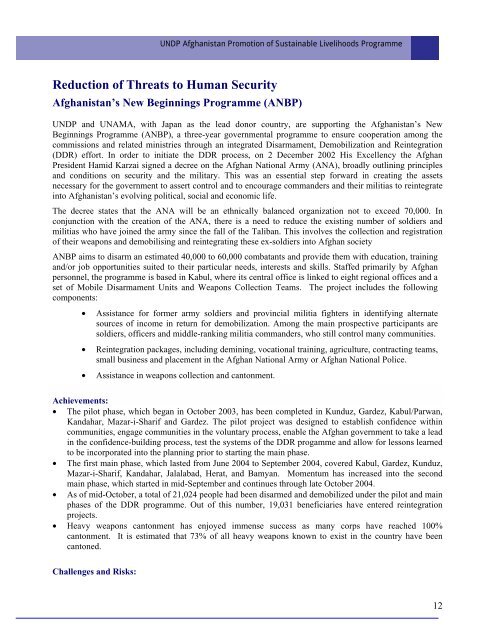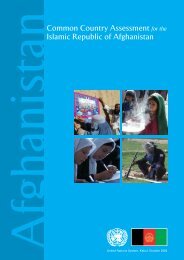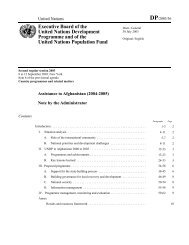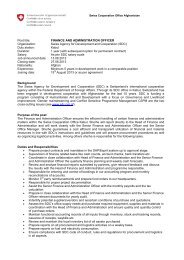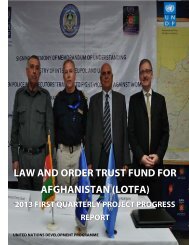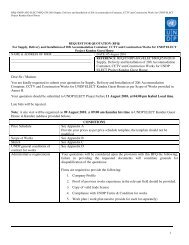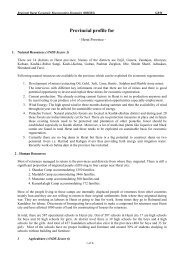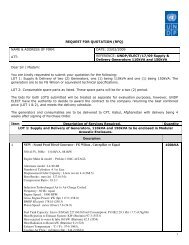Promotion of Sustainable Livelihoods - UNDP Afghanistan
Promotion of Sustainable Livelihoods - UNDP Afghanistan
Promotion of Sustainable Livelihoods - UNDP Afghanistan
Create successful ePaper yourself
Turn your PDF publications into a flip-book with our unique Google optimized e-Paper software.
<strong>UNDP</strong> <strong>Afghanistan</strong> <strong>Promotion</strong> <strong>of</strong> <strong>Sustainable</strong> <strong>Livelihoods</strong> Programme<br />
Reduction <strong>of</strong> Threats to Human Security<br />
<strong>Afghanistan</strong>’s New Beginnings Programme (ANBP)<br />
<strong>UNDP</strong> and UNAMA, with Japan as the lead donor country, are supporting the <strong>Afghanistan</strong>’s New<br />
Beginnings Programme (ANBP), a three-year governmental programme to ensure cooperation among the<br />
commissions and related ministries through an integrated Disarmament, Demobilization and Reintegration<br />
(DDR) effort. In order to initiate the DDR process, on 2 December 2002 His Excellency the Afghan<br />
President Hamid Karzai signed a decree on the Afghan National Army (ANA), broadly outlining principles<br />
and conditions on security and the military. This was an essential step forward in creating the assets<br />
necessary for the government to assert control and to encourage commanders and their militias to reintegrate<br />
into <strong>Afghanistan</strong>’s evolving political, social and economic life.<br />
The decree states that the ANA will be an ethnically balanced organization not to exceed 70,000. In<br />
conjunction with the creation <strong>of</strong> the ANA, there is a need to reduce the existing number <strong>of</strong> soldiers and<br />
militias who have joined the army since the fall <strong>of</strong> the Taliban. This involves the collection and registration<br />
<strong>of</strong> their weapons and demobilising and reintegrating these ex-soldiers into Afghan society<br />
ANBP aims to disarm an estimated 40,000 to 60,000 combatants and provide them with education, training<br />
and/or job opportunities suited to their particular needs, interests and skills. Staffed primarily by Afghan<br />
personnel, the programme is based in Kabul, where its central <strong>of</strong>fice is linked to eight regional <strong>of</strong>fices and a<br />
set <strong>of</strong> Mobile Disarmament Units and Weapons Collection Teams. The project includes the following<br />
components:<br />
• Assistance for former army soldiers and provincial militia fighters in identifying alternate<br />
sources <strong>of</strong> income in return for demobilization. Among the main prospective participants are<br />
soldiers, <strong>of</strong>ficers and middle-ranking militia commanders, who still control many communities.<br />
• Reintegration packages, including demining, vocational training, agriculture, contracting teams,<br />
small business and placement in the Afghan National Army or Afghan National Police.<br />
• Assistance in weapons collection and cantonment.<br />
Achievements:<br />
• The pilot phase, which began in October 2003, has been completed in Kunduz, Gardez, Kabul/Parwan,<br />
Kandahar, Mazar-i-Sharif and Gardez. The pilot project was designed to establish confidence within<br />
communities, engage communities in the voluntary process, enable the Afghan government to take a lead<br />
in the confidence-building process, test the systems <strong>of</strong> the DDR progamme and allow for lessons learned<br />
to be incorporated into the planning prior to starting the main phase.<br />
• The first main phase, which lasted from June 2004 to September 2004, covered Kabul, Gardez, Kunduz,<br />
Mazar-i-Sharif, Kandahar, Jalalabad, Herat, and Bamyan. Momentum has increased into the second<br />
main phase, which started in mid-September and continues through late October 2004.<br />
• As <strong>of</strong> mid-October, a total <strong>of</strong> 21,024 people had been disarmed and demobilized under the pilot and main<br />
phases <strong>of</strong> the DDR programme. Out <strong>of</strong> this number, 19,031 beneficiaries have entered reintegration<br />
projects.<br />
• Heavy weapons cantonment has enjoyed immense success as many corps have reached 100%<br />
cantonment. It is estimated that 73% <strong>of</strong> all heavy weapons known to exist in the country have been<br />
cantoned.<br />
Challenges and Risks:<br />
12


